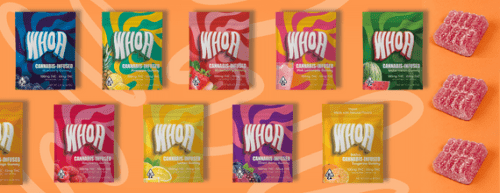400 known terpenes have been found in cannabis, but only a limited amount have been studied and are known to have specific effects. Some of the most common and studied terpenes found in cannabis include the terpinolene terpene, limonene, linalool, myrcene, humulene, pinene, and caryophyllene. Potential effects include anxiety relief as well as mood-enhancing, sedative, antibacterial, antifungal, and anti-cancer properties.
THC may be the most popular and prominent compound in the cannabis plant, but it’s not the only one. In fact, there’s hundreds of compounds found in cannabis plants; the most common being cannabinoids and terpe
Terpenes are chemical compounds that naturally occur in plants, including cannabis. They’re to thank for the aromas, flavors, and even colors associated with cannabis as well as potentially altering the effects and therapeutic benefits.
Terpinolene Terpene in Cannabis

Image via The Bud Hunters Grow IG
Terpinolene
While those previously mentions terpenes are the most prominent, there are plenty of others that are found in small amounts in cannabis, but still have plenty to offer. One of these terpenes is terpinolene— known as the “least-common common terpene.” It’s almost always found in a strain’s profile, but not usually in high amounts. This doesn’t mean it’s unimportant and ineffective. Terpinolene has plenty to offer, even in small amounts.
Let’s dive into everything that terpinolene has to offer.
Terpinolene: Aroma & Flavors
While some terpenes have a very distinct smell— such as limonene’s citrus scent— terpinolene holds a more multidimensional aroma. Its scent is reminiscent of a walk through a forest during Spring— piney, floral, and herbaceous. It even holds a bit of a citrus scent, similar to limonene.
Terpinolene is also found in many other plants and foods, including lilacs, nutmeg, tea tree, apples, and cumin. The highest concentrations of terpinolene are in parsnip. It’s also commonly added to soaps and perfumes due to its fresh scent and taste.
Terpinolene: Effects & Benefits
Terpinolene doesn’t necessarily steer the effects that a strain may offer, but rather contributes to the overall experience. It is believed that terpenes and cannabinoids work together to create the overall effects of a strain. So even if a strain has a dominant terpene, that doesn’t mean that the strain will necessarily have the same properties as that terpene.
Nonetheless, terpinolene offers a range of potential benefits.
Research suggests that this terpene has healing effects, including antibacterial, antifungal, and anti-proliferative properties, which may inhibit the growth of cancer cells. It’s also an antioxidant, which means it may prevent oxidation damage to molecules in the body. Further, terpinolene is thought to have anti-insomnia and sedative properties, aiding with healthy sleep. It may even help to improve cholesterol levels and reduce the risk of heart disease.
Research also suggests that terpinolene can help repel pests such as mosquitos and weevils.
Terpinolene: Strains
It’s estimated that about one in ten strains are dominant in the terpinolene terpene. Although it’s not as common as terpenes such as limonene and pinene, its dominant presence in around 10% of strains is much more than the majority of compounds. Higher levels of terpinolene are typically found in sativa dominant cannabis plants.
5 Strains That are Terpinolene-Dominant

Image via Wikimedia
Jack Herer
Jack Herer, also known as The Jack and Platinum Jack, is a renowned strain that nearly every cannabis consumer has heard of or tried. It is one of the most popular sativa-dominant strains. Jack Herer is made by combining a Haze hybrid with a cross of Northern Lights #5 and Shiva Skunk.
This strain has a heavy resin production, making it on the higher end of the potency spectrum, sitting around 18-21% THC on average. In addition to its high content of terpinolene, Jack Herer also usually has a high content of the cannabinoid cannabigerol (CBG). Jack Herer may offer cerebral elevation with energizing effects to create a blissful, clear-headed, and creative high.
Golden Goat
Golden Goat is a hybrid strain that was created on accident in Kansas but has since become a widely popular cultivar. A male Hawaiian-Romulan plant pollinated Mr. Dank’s Island Sweet Skunk, creating what we know as Golden Goat. This strain sits on the higher end of the potency spectrum, with around 19% THC on average. In addition to its high content of terpinolene, Golden Goat may contain around 1% of CBG.
As a hybrid, the Golden Goat strain holds a range of potentially balanced effects. Users claim that Golden Goat has full-body effects that offer a delightful rush of euphoria and creativity.
Super Lemon Haze
Super Lemon Haze, also known as SLH, is a very popular and award-winning sativa-dominant hybrid strain. The two-time Cannabis Cup winner is a cross between Lemon Skunk and Super Silver Haze. Super Lemon Haze offers potentially uplifting and energizing effects, holding an overall lively feeling. It holds a high content of THC, sitting around 19% usually, as well as having, on average, around 1% CBG.
Though the name and flavors suggest that limonene would be the dominant terpene, terpinolene actually is. It holds a citrusy, zesty aroma and sweet flavor that may remind you of lemonheads candy.
Orange Cookies
Orange Cookies is a sativa-dominant hybrid that is a part of the wildly famous Cookies family. This strain is made by crossing the hybrid Orange Juice with the renowned Girl Scout Cookies. The result is a balanced strain that offers potentially euphoric yet calming effects; this may lend users relief from anxiety and depression. The potent strain typically sits at around 20% THC with 1% CBG.
As the name suggests, it is packed with sweet flavors that will remind you of juicy tangerines and oranges. Its dominant terpene, terpinolene, is partially to thank for that, as it holds hints of citrus.
Dutch Treat
Dutch Treat, an Amsterdam coffee shop staple, is a hybrid strain made by crossing Haze with Northern Lights. This means it has two landrace strains in its family tree, Afghani and Thai. The result is a balanced strain with potential cerebral, uplifting, and euphoric effects that may help with mind-body relaxation and reducing stress. Dutch Treat is a potent strain with around 19% THC and 1% CBG.
As its name suggests, Dutch Treat tastes and smells like dessert. It holds sweet, fruity notes with hints of citrus and pine, thanks to its high content of terpinolene.
–
Pair your next smoke session with a Triple hemp THC seltzer or lemonade or a Happie hemp THC seltzer — use code RespectMyRegion20 at checkout for a discount on Happie products. Both deliver smooth, uplifting effects that enhance relaxation and complement your favorite terpenes.
Affiliate Disclaimer:
Some links in this article may be affiliate links. Respect My Region may earn a small commission if you purchase through them. The code “RespectMyRegion20” provides a discount on Happie products. All products are intended for adults 21+ and compliant with hemp and cannabis laws where applicable. Respect My Region does not sell or distribute THC or hemp-derived products directly.
More Content
THE RELATIONSHIP BETWEEN BACKWOODS AND HIP-HOP
TERPENES FOR ANXIETY: 3 TERPS IN CANNABIS WITH STRESS-RELIEVING PROPERTIES
RAPPER WEED: WHICH RAPPERS HAVE CANNABIS PRODUCTS IN THE MARKET? WHO ACTUALLY HAS THE FIRE?
18 COMPANIES THAT DON’T DRUG TEST THEIR EMPLOYEES FOR WEED
7 TIPS FOR MARKETING CANNABIS AND CBD ON TIKTOK AND INSTAGRAM

FOR MORE CANNABIS & MUSIC NEWS, FOLLOW RESPECT MY REGION ON FACEBOOK & TWITTER.
TO HAVE A STORY FEATURED OR YOUR BRAND OR PRODUCTS REVIEWED, PLEASE EMAIL US.
.
Pair your next smoke session with a Triple hemp THC seltzer or lemonade or a Happie hemp THC seltzer — use code RespectMyRegion20 at checkout for a discount on Happie products. Both deliver smooth, uplifting effects that enhance relaxation and complement your favorite terpenes.
Affiliate Disclaimer:
Some links in this article may be affiliate links. Respect My Region may earn a small commission if you purchase through them. The code “RespectMyRegion20” provides a discount on Happie products. All products are intended for adults 21+ and compliant with hemp and cannabis laws where applicable. Respect My Region does not sell or distribute THC or hemp-derived products directly.







